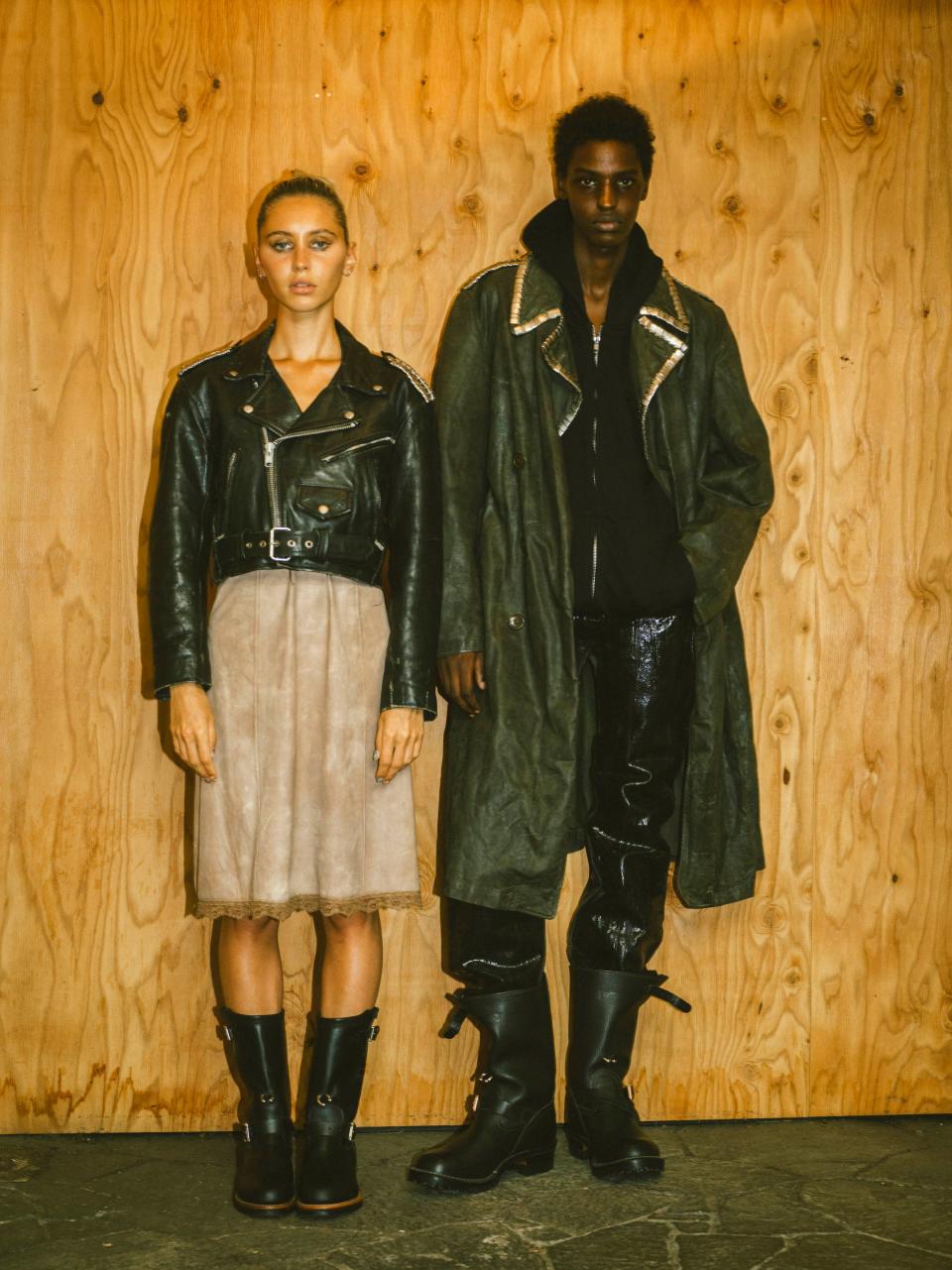Luka Sabbat’s New Clothing Brand Is for Fashion Fetishists

Courtesy of Mitchell McCormack
Luka Sabbat is telling me about his new clothing line. The samples are mostly in Japan, somewhere in the production process, but he has a ballcap with him. It’s greenish brown and kind of oily, and roughly distressed like it got dipped in a wheat thresher. I can’t really place the hat’s slightly unsettling vibe. Sabbat is happy to explain.
“Piss and shit was kind of the inspiration,” he says.
The hat is the first product he developed for a brand called Marking Distance. The “Crust Hat” retails for $225. It doesn’t just look slightly revolting, but also feels stiff and gross, like it’s been dragged through a cesspool then left out to congeal in the hot sun. If the scatalogical texture is too much for you, a slightly more subtle version—the Spunk Hat—has what looks like dried semen sprayed all over it.
I find the 26 year-old actor and artist and all-around cool guy in the lair of a true fashion rock star: a room at the Bowery Hotel that smells of freshly blasted Marlboros, clothes spilling out of a Rimowa trunk splayed on the floor. Next to a massive bouquet of half-dead pink flowers, Sabbat is lounging in Balenciaga Couture jeans and a distressed hoodie zipped down to his bare belly. His business and design partner, James Pierce, is sitting nearby in camo pants and combat boots. Sabbat is telling me about Japan, where he spent a good part of the year working on the first Marking Distance collection. “I can carry the most basic conversation,” he says of his language skills. “A lot of it is party Japanese. Like, What are you doing after this?”

As he explains it, Marking Distance is a middle-finger to the fashion world’s obsession with refinement. “Everything in fashion is about looking clean,” he says with clear disdain. Following a brief period where many fashion designers reflected the world’s state of disorder and despair back at their audience, recently beauty has been the order of the day. The signs are everywhere, from the sequins and flowers all over the runways to the sense of formality, structure, and refinement that pervades the streets.
Sabbat is more into what you might call sartorial edging. He didn’t particularly want to start a brand, having “been around this shit forever” and “seen too many people start brands.” But he saw an opening for a project that was visceral and physical—and kinky. Piss and shit was only the start. “Things that aren't very public,” he says, explaining the idea behind the brand. “How can we normalize these gross things?”


The first Marking Distance collection would feel at home in an haute sex shop. There’s a military-style jacket with a ball gag collar attachment, a slip dress affixed with nipple clamps, and a hoodie complete with nipple weights. They sourced a handful of Tom of Finland-esque Wesco biker boots at an actual fetish shop in Chelsea, and added piercings to the thick leather. All of the fetish objects are removable, just in case. “We want to give people the option to showcase this side of themselves and have that conversation, because not everybody is into that kind of stuff,” says Sabbat.
Other pieces evoke the gunk of clothes that are muddied and molded, he explains. “So some of this stuff is literally gross, because that is part of fetishism.” The grossness dovetails with Sabbat’s obsession with grungy vintage garments. “We just like things that feel real, that feel worn,” he says. “It’s the idea of clothing having real life,” adds Pierce.

Marking Distance began unassumingly enough, as an Instagram account Sabbat used to post photos from his jet-set life: portraits of famous friends, and diaries from the Met Gala and clubs in Tokyo. (The name stems from his habit of logging the mileage of his peripatetic travels.) They met when Pierce, a former Interview Magazine intern who also worked for the stylist and costume designer Mimi Fisher, was starting his own brand. He was experimenting with distressed ballcaps, and Sabbat was trying to make his own out of leather. They linked up and bonded over a love of punk and metal and military clothing, and drew up a brand blueprint on a tablecloth at East Village scenester spot Lucien. (“I hate to say it, but it's the truth,” says Pierce.) Sabbat is funding the endeavor himself.
His main account (4.2 million followers), he says, is where he plays the character that is Luka Sabbat, the brand-friendly mega-influencer who collaborates with the likes of Ralph Lauren and Guess. Marking Distance, on the other hand, quickly became his true creative outlet, a way to showcase the various artistic forays he pursued outside of his day job. As with most finstas, his side account, he says, “Is actually me and the stuff that I’m into.”
Sabbat made a career out of showing off the stuff he’s into. He spent much of his youth hanging around SoHo, flipping Supreme and using the cash to fuel his extremely advanced taste in Raf Simons and Rick Owens. He has said, accurately, that he was one of the first internet fashion kids of New York, and he was also one of the best in the emerging field of style influence, because he had a singular knack for making getting dressed look as easy as rolling out of bed. He wore rare Vetements and archival Ann Demeulemeester as if it was a perfectly normal thing for a teenager to do, and perfected a look that told you he didn’t care what you thought. He signed a modeling contract at 15 and became buddies with Virgil Abloh. Soon enough, Sabbat had become an international emblem of cool, a “Gen-Z Chloë Sevigny,” as The Cut once called him, who parlayed his platform into other projects like acting gigs (he appeared in Jim Jarmush’s 2019 zombie flick The Dead Don’t Die alongside, naturally, Sevigny herself).



Now, as Marking Distance reveals, he’s maybe more like a Gen-Z Dash Snow. “I mean, it's something that if you know me, I've always kind of been into,” says Sabbat, when I ask about the Balenciaga-bondage vibe. He pulls out his phone to show me some sculptures he’s been working on. One is a fully functioning urinal, where you pee into the gaping mouth of a lifesize figure in a submissive pose wearing a gimp mask. (The urine empties out through a hole in the kneecap.) It was inspired by a scene Sabbat encountered one time in the bathroom at Berghain, and he hopes to one day install it there. “I can't make art about shit that I'm not into or not experiencing and haven't seen, you know what I mean?” he says. They’re both obsessed with films like Scorpio Rising and Cruising, and the uniforms of hardcore and punk bands, and see the brand as an homage to these style trailblazers. “It's so easy to reference fucking fashion,” says Sabbat. “We're referencing things that we're actually into.”
Pierce, with a twinkle in his eye, shares his own, very different kind of dirty inspiration: Filthy jeans worn by an oil rig worker. “You go and get a pair of jeans off a guy who’s been working on an oil rig, and the amount of layers in those…” Several pieces reveal their plain obsession with the way clothing can convey specific attitudes, like a luxe version of St. Marks crust punk pants made in white leather patchwork jeans strung together with what looks like dental floss. An officer leather jacket, studded with spikes and Bic lighter caps, looks fit for the world’s scariest motorcycle club bouncer. A crushed bomber jacket with a matted fur hood is emblazoned with the kinkiest detail of all: a Notre Dame patch.
Pierce handles production, which he describes as deeply experimental. It turns out that replicating bodily fluids and decomposition is not easy. In order to create the samples, he had to turn his New York apartment into a DIY dye factory. “There was powder and wax and copper and liquid rubber and god knows what all around.” When successful, Pierce’s results can cause minorly dissonant sensory experiences, like when I encountered Sabbat at an event in the spring. He was wearing what looked like shiny black leather jeans, but when he invited me to touch them I discovered they were in fact made of what felt like an inch of filmy rubber. Pierce had slathered a pair of Levi’s with a bucket of black Flex Seal. “There's a really real physical materialistic element that is outside of any, I guess, just fashion element,” Pierce says of his work.

Following a limited release of hats, tees, and hoodies at ComplexCon in November, where Sabbat recreated the Chateau Marmont hotel room where he lived for most of the pandemic, the plan is to take orders for the full collection in Paris in February. Most of it is going to be expensive. “We want some things to be accessible for an entry-level consumer, but we are wanting this to be high fashion, or whatever the fuck that means,” says Sabbat. Pierce adds: “Luxury, for sure.” They say they’re open to doing a runway show in the future, but not during fashion week, and they plan to resist the industry’s seasonal logic. “One collection a year is enough,” says Sabbat.
In the meantime, their experiments in capturing the grosser side of clothing continues. “It's easy to take some metal graphic and repurpose it, but it's like we're trying to really get into what these people wore,” says Sabbat. “A lot of the black metal guys, they used to bury their clothing in soil so it would rot the denim.”
So they took a pair of denim and dug a hole in the backyard of James’s parents place in Long Island. They left other pairs on the roof. But the buried jeans, when exhumed after two full months, were what really got them going. “It was awesome, yeah, it was sick,” says Pierce. Recalling the jeans, Sabbat was definitive: “It was,” he says proudly, “fucking disgusting.”
Originally Appeared on GQ

